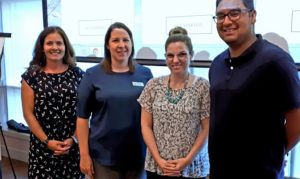First Nations-led study yields new digital tools to promote economic growth and employment

By Colin Graf
AAMJIWNAANG FIRST NATION— A group of seven First Nations in southwestern Ontario is getting a new set of digital tools to help their leaders work together in promoting employment and economic growth.
The online suite of tools includes a skills bank of members looking for work, a webpage for would-be entrepreneurs to check the viability of their business plan, and a community asset-mapping tool, says Ashley Sisco, a London, Ont., consultant who has helped develop the toolkit.
The new tools are the product of a study began by the Southern First Nations Secretariat, the economic development agency working for the seven nations in 2016, which looked at “leakage”— the amount of money First Nations administrations are spending outside of their own and other nearby Indigenous communities. The nations involved include Aamjiwnaang First Nation, Caldwell First Nation, Chippewas of Kettle and Stony Point First Nation, Chippewas of the Thames First Nation, Delaware Nation, Munsee Delaware Nation, and Oneida Nation of the Thames.
Finding only 13% of their Chiefs and Councils’ spending was happening locally, a committee from the seven nations decided to commission Sisco to develop tools to improve that situation. The first tool, an online skills bank, allows members of the nations to post their resumes and skills for viewing by possible employers. With about 150 job seekers who have posted profiles, Sisco hopes Councils and other employers will find it easier to hire locally by using the new tool. Some large outside employers in the area are looking to hire more First Nations people as a response to the Truth and Reconciliation Commission’s Calls to Action, she says, and “we are trying to make them accountable for hiring locally as well.”
Another digital approach in the “one-stop shop” to help business development is an online business viability tool, a webpage that Sisco says allows entrepreneurs from the seven First Nations to check how likely their business is to attract First Nations customers from their area. Based on data compiled by her firm, the tool checks the size of the local market and service area and calculates potential revenue. If new business developers concentrate on the market in their own communities, it will help recapture some of the leaking money, she explains.
The new tools result from determined collaboration among the group of First Nations. The inter-community committee has been “instrumental in guiding the work” that’s led to the new toolkit. In the past, communities have developed lengthy reports that have a lot of great information used by administrators for planning and funding applications, but that information was not always easily accessible for everyone, she says. The new SFNS toolkit is “designed to make the data usable” and help “strengthen and localize” the nations’ economies, according to the consultant.
While reducing economic leakage is a good goal for First Nations administrations, it is clear communities cannot live in a “closed economy” and much money will have to be spent elsewhere, Sisco says. Some leakage is “absolutely healthy and fine” but it can be reduced by hiring and buying locally, she explains. Some areas of necessary outside spending are electricity, group benefits, and higher education, she notes. She adds that even those can be localized to some extent.
Another tool developed through SFNS allows administrators to develop scenarios for different First Nations to arrange group purchasing of electricity, insurance, or internet service. Sisco says that could save up to 30 percent on those bills for band offices. The member nations have created the SFNS Cost-Sharing Circle to look at that possibility and also the hope of purchasing group benefits for employees of the member nations, she says. The Circle members hope to draft an agreement-in-principle and then negotiate each specific area next year, she adds.
Another committee is talking with post-secondary colleges and universities about tuition costs for members and trying to get more programs to be offered on First Nations.
“We’re making some headway there,” claims Sisco.
This group is working to make sure programs are “accessible, localized, and in areas of high leakage,” according to Sisco. They hope more courses can be offered on the First Nations along with increased online offerings. One day perhaps an educational institution can be developed in one of the member communities, she adds.
The Southern First Nations Secretariat is also creating a “community asset mapping tool” using Google maps to code different economic strengths in each community. A youth co-researcher from each nation is helping identify resources, people, facilities, and associations, Sisco explains.
“We’ve already had people say, ‘Hey – we don’t have any plumbers but we notice you guys do’,” she says. “One First Nation might have a warehouse to store things when another is looking for a place to store things.”
More ideas are still being worked on for the toolkit, Sisco says, and expects the results of this new work will start to be seen even more in coming months.

